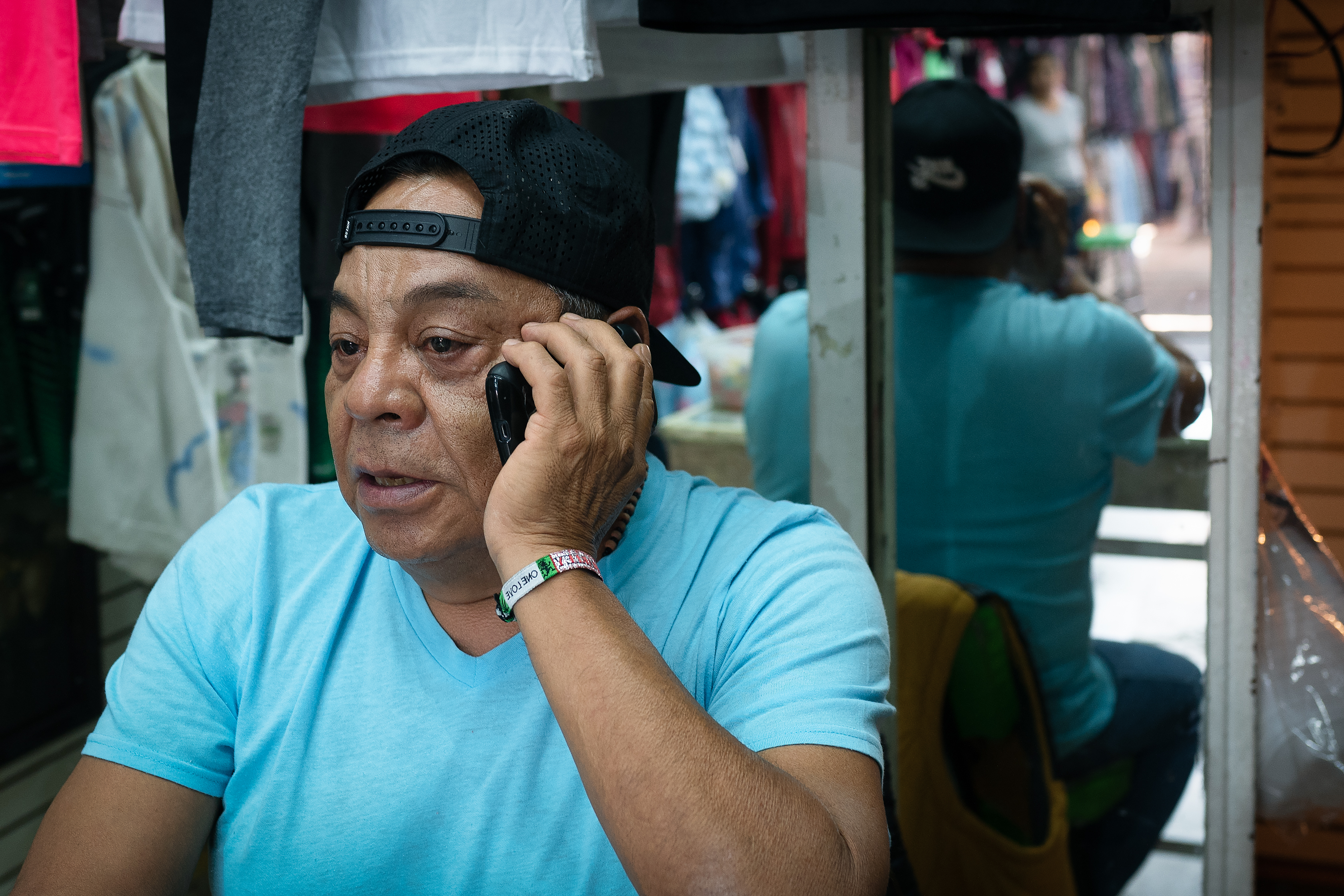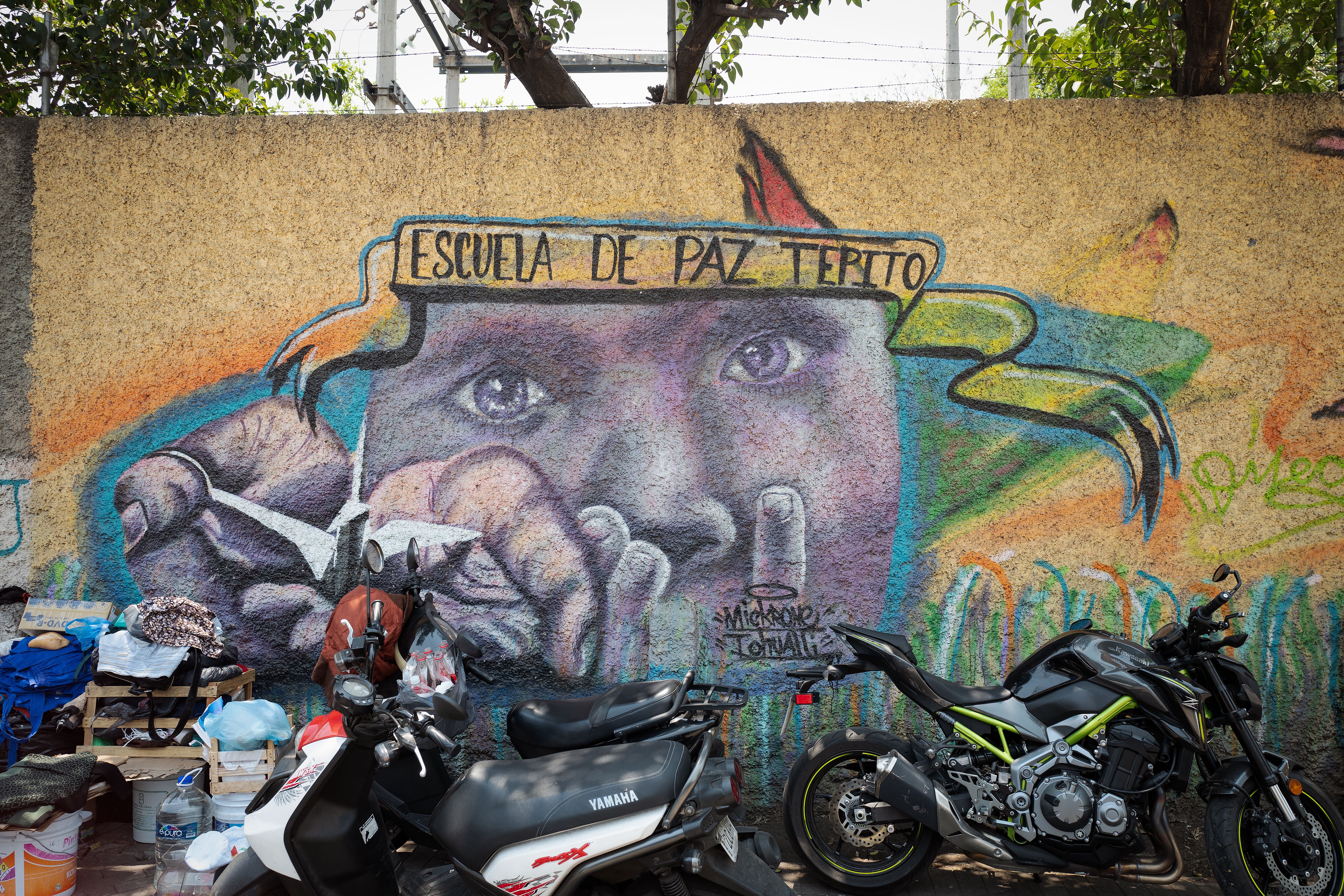Extreme Cartel Violence Has Come to Mexico City
CARTEL CHRONICLES is an ongoing series of dispatches from the front lines of the drug war in Latin America.
Contraband watches, shoes, and DVDs. Drugs. People. Guns. Justice. There’s nothing money can’t buy in Tepito, one of Mexico City’s most infamously tough neighborhoods.
But on a recent Monday morning, the local market, which normally features hundreds of vendors hawking everything you can think of, was missing some of its usual hustle and bustle. Stalls stood abandoned because vendors could not afford the extortion payments demanded by La Unión, the local cartel.
It may seem like a bit of local trouble in a country torn apart by cartel violence. But in Mexico City, viewed as a relative safe haven from cartel influence, developments in Tepito are prompting some locals VICE spoke with to ask whether the city's partial immunity from Mexico's drug war is over.
Last month, Raymundo Pérez López, the head of an association that claims to represent hundreds of informal businesses in downtown Mexico City, issued a public plea to city authorities for help against the cartel-run extortion rackets devastating their profits.
In a letter sent to the city prosecutor's office, signed by more than 240 local sellers, the association warned: “Those of us who haven’t abandoned our businesses continue to survive on a tiny profit margin, which grows more miserable by the day. Everything has its limits.”
Some local businesses are reaching a breaking point under the extortion demands of La Unión. The mini-cartel is diversifying out of drug trafficking and arms-dealing and tightening the screws on local business people, who have had enough. Now, to complicate things further, vendors in Tepito have talked of creating their own protection group.
“It wouldn’t surprise me if the commercial community formed its own self-defense group, given the slowness and lack of action by the authorities," said López. It's a threat, not a promise, but one that could mark a new milestone in Mexico’s decade-long drug war.
It didn't take long for López to be silenced. On Saturday, he was shot seven times and killed as he was getting into his car in a suburb just north of Tepito, according to local media reports.
Self-defense groups against the cartels, known as autodefensas, have emerged across Mexico over the last decade, with communities taking up arms in some of the most violent states, such as Michoacán and Guerrero. They rose to fame in the local and international media, pictured riding around masked, touting heavy weaponry in open-topped trucks and improvised checkpoints, claiming to be protecting themselves against violent drug gangs who want to control routes, drug markets, extortion rackets, and pilfer local resources such as timber. But they have a mixed reputation. In some states, they are reported to work with, not against, local crime gangs.
“The possibility of a self-defense group in the capital is a terrible sign because it shows the incapacity of the authorities to establish order,” said Juan Francisco Torres Landa from the advocacy group Mexico United Against Crime (Mexico Unido Contra de la Delincuencia).
It’s not only extortion rackets that are spiraling out of control in Mexico City, a sprawling capital that is home to some 20 million people. Murder in the capital is reaching unparalleled levels.
Rivalries between warring criminal groups over drug trafficking and plazas (territories) are generating the kind of brutality usually reserved for the provinces. There were more than 250 homicides in the city in the first three months of this year, some 35 percent more than the same period last year, and 75 percent more than in 2016. The rising tide in Mexico City reflects a national trend: Across the country, murders increased by almost ten percent year on year.
It is the blatant nature of some of these killings in the capital that is especially unusual. In September last year, gunmen dressed as mariachi musicians opened fire on revelers in Plaza de Garibaldi, a downtown Mexico City spot popular with tourists. They killed five people, and wounded at least as many more. In a different incident, body parts were left strewn across the city’s main traffic artery in June, the possible result of a spat between La Unión and a rival crime group.
Antonio Nieto, a journalist and co-author of a new book on drug trafficking in Mexico City called NarcoCDMX, said the city has always been violent, but it’s getting noticeably worse.
“There is a general trend to use extreme violence now, which I haven’t seen before," he said. "There have always been killings and gunfights, contraband, drug sales, and famous sicarios, but what’s different now is how they kill and exhibit the bodies. Now they cut them up, leave them with mantas (homemade signs showing a message to criminal groups), use more extreme violence—perhaps inspired by what’s happening in the rest of the country.”
Mexico City’s new mayor, Claudia Sheinbaum, has responded publicly to the pleas and threats from the vendors in Tepito by promising to work with locals to develop a plan of action to help them combat extortion without resorting to vigilante violence.
She is right to be concerned about talk of launching a self-defense group, because that’s how La Unión, Tepito’s current crime lords, was initially born some ten years ago.
La Unión started out as a small protection outfit created by the community in an effort to shelter locals from crime, Jefe Santos, a prominent community leader, salesman, and Tepito lifer told me from his small clothes stall in the market. Businesses around the neighborhood started out paying La Unión a small wage for protection, and had a good relationship with the hired heavies. With the passing of time, protection rackets turned into racketeering. "Pay us and we won’t let those hoodlums mess with you," turned into, "Pay us or we will mess with you."

“La Unión started to get stronger and stronger, and a lot of people started getting killed,” said Santos. “Tepito doesn’t want La Unión anymore, because there is too much killing, too much violence. Today, a lot of young people from Tepito are turning into paid killers.”
So far, Mexico City has not featured such self-defense groups. And the city’s government has long claimed that organized crime does not operate here. But observers disagree.
“This line [from the government] that there is no organized crime or bosses in Mexico City is totally unacceptable and a lie. This is the most important [drug] market in the country, so it’s ridiculous to say that they don’t have a presence,” said Landa.
And it’s no coincidence that this apparent cry for help comes out of Tepito, one of the capital’s most notorious barrios. It’s home to a famous shrine, dedicated to Santa Muerte, Saint Death, a figure worshipped by drug traffickers as well as residents for blessings and her powers of protection. Everyone who comes to Santa Muerte wants protection from the neighborhood ills—theft, drug addiction, and extortion. But some residents think it’s too late for prayers.
Meanwhile, if La Unión—which appears to be squeezing locals via extortion as it diversifies out of drug trafficking—is not as welcome anymore, the group's members don't seem to care.
Despite a number of high-profile arrests of local leaders by the authorities, as well as the murder of its founder, their reign continues. A back-of-a-napkin calculation gives a rough idea of the spoils the extortion rackets offers: If the estimated 2,500-5,000 stalls (according to Santos) in the market—not taking into account other small informal businesses around the neighborhood—pay a mere $50MX a day (around US $2.60), La Unión is making $125,000 to 250,000MX daily. That’s more than US $13,000. Per week, that’s 1,250,000 pesos, or more than US $65,000. Profits from drug trafficking, weapons dealing, and other criminal activities are added to that.
Nieto and other observers suggest this points to other motives behind the appeal of the vendors for protection from the city government. “During my investigations over ten years, I’ve found that a lot of the business leaders are also involved in drug dealing," Nieto said. "So how can you know how many of those who are complaining [about extortion] are doing so because they’re legitimate victims or rather because their illicit businesses are being affected by other drug dealers and criminal groups?”
His suspicions were corroborated further by the refusal of the business association to speak with VICE about its members' plight. We went to their offices to request an interview but our emissary was met with hostility, and held captive for half an hour. López's people accused us of being sent from La Unión to seek revenge. They said that another local vendor had been killed by the cartel in retaliation for the letter. Eventually, they let us go, minus a wallet. But as Nieto suggests, it’s possible that the plea for help could be a different criminal faction trying to bring heat from the authorities onto its rivals to protect its own criminal interests.

Santos, and other sources in Tepito who did not wish to be named for safety reasons, said that proposing to stand up to La Unión is akin to signing your own death warrant. Threatening to take up arms against a dominant cartel that is squeezing you dry via the use of violence does seem naïve, at best.
The jostling for control over Mexico City’s valuable extortion and drug trafficking markets group suggests that a trend affecting organized crime across Mexico is hitting the capital. As authorities have focused on the kingpin strategy—going after leaders such as the Sinaloa Cartel’s Joaquin “El Chapo” Guzman and the still-at-large Nemesio Oseguera Cervantes, also known as “El Mencho,” from the Jalisco New Generation Cartel—big criminal organizations have fragmented into smaller, less hierarchical organizations. Without a centralized operation, these organizations have also further diversified into other criminal activities such as extortion and kidnapping, which arguably have lower barriers to entry.
Mexico’s government has not succeeded in taming the cartel beasts around the country. With matters in the capital spiraling, it’s hard to be optimistic about the ability of the authorities to turn things around there. Tepito is just one of many troubled, cartel-controlled urban zones, and its criminal evolution will serve as an example to the city. However the state decides to tackle things, it’s not going to be easy.
Jorge Vega, a former boxing champ and another Tepito lifer, said he wasn’t surprised at López's murder. “La Unión killed him because he didn’t want to cooperate. Tepito has had years of this.... You can’t change things. If you fuck with the barrio, the barrio will fuck with you.”
Sign up for our newsletter to get the best of VICE delivered to your inbox daily.
Follow Deborah Bonello on Twitter.
420GrowLife
via DMT.NEWS, Deborah Bonello
May 7, 2019 at 12:54PM
